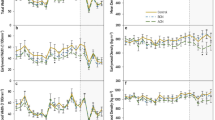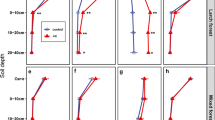Abstract
Forested wetlands in the Northern Great Lakes Region are becoming increasingly used as a timber resource. Yet, limited information is available on the effects of harvesting and post-harvest manipulations (site preparation and fertilization) on tree and ground vegetation in these wetland communities. The objective of this study was to examine production changes and species diversity in the vascular plant community four years after a forested, mineral wetland in Northern Michigan was whole-tree harvested, site prepared (bedded or trenched), and fertilized (N, P, N + P). The wetland had an original overstory of black spruce (Picea mariana), tamarack (Larix laricina), and jack pine (Pinus banksiana), with a significant cover ofSphagnum and Ericaceous shrubs. Site preparation techniques were done immediately after harvesting. The site was then planted with jack pine seedlings (1–0 stock). Fertilization occurred four years after harvesting and site preparation. Results indicate that trees in bedded areas with N fertilizer applied had significantly greater total seedling height, basal diameter, and height increment when compared with those from harvest-only or trenched areas. On harvest-only areas, seedling production was greater with P and N + P fertilizers than with N fertilizer alone. Fertilizer responses were attributed to which type of site preparation (bedding versus trenching) was used and the degree of organic matter andSphagnum incorporated into the mineral soil. Only site-preparation treatments (not fertilization treatments) had significant effects on numbers and cover of vascular plant groups (woody, herbaceous, and grass/sedge). Number of species and total cover of all vascular plants were significantly greater on the harvest-only areas than on trenched, bedded, or uncut areas. As expected, relative cover of the grass/sedge group increased with increasing site disturbance (bedded and trenched), mainly due to disturbance and lack of the thickSphagnum mat. When compared to the adjacent uncut area, relative cover of herbaceous species was significantly reduced on treated areas. In future years, if the significant effects of manipulation treatments on tree productivity and vascular plants continue, the resulting community may be different than the successional sequence witnessed by the original forest. This will, however, depend on the rate of crown closure and the invasion of bryophyte species.
Similar content being viewed by others
Literature Cited
Abrams, M.D. and D.I. Dickman. 1983. Response of understory vegetation to fertilization on mature and clear-cut jack pine sites in Northern Lower Michigan. American Midland Naturalist 110: 194–200.
Akerstrom, L. and B. Hanell. 1996. Mound characteristics affect growth and survival of Norway spruce seedlings. p. 429–436.In C.C. Trettin, M.F. Jurgensen, D.F. Grigal, M.R. Gale, and J.J. Jeglum (eds.) Northern Forested Wetlands: Ecology and Management. Lewis Publishers, Boca Raton, FL, USA.
Alban, D.H. and R.F. Watt. 1981. Fertilization of black spruce on poor site peatland in Minnesota. USDA Forest Service, North Central Forest Experiment Station. St. Paul, MN, USA. Research Paper NC-210.
Albert, D.A., S.R. Denton, and B.V. Barnes. 1986. Regional landscape ecosystems of Michigan. School of Natural Resources, Ann Arbor, MI, USA.
Allen, H.L. and R.G. Campbell. 1988. Wet site management in the Southeastern United States. p. 173–184.In: D.D. Hook, W.H. McKee, Jr, H.K. Smith, J. Gregory, V.G. Burrell, Jr, M.R. De Voe, R.E. Sojka, S. Gilbert, R. Banks, L.H. Stolzy, C. Brooks, T.D. Matthews, and T.H. Shear (eds.) Ecology and Management of Wetlands. Volume 2: Management, Use, and Value of Wetlands. Timber Press, Portland, OR, USA.
Benzie, J.W. 1963. Cutting methods in mixed conifer swamps, Upper Michigan. USDA Forest Service, St. Paul, MN, USA. LS-4.
Benzie, J.W. 1977. Manager’s handbook for jack pine in the north central states. USDA Forest Service North Central Forest Experiment Station, St. Paul, MN, USA. General Technical Report NC-32.
Berdnt, L. 1967. Soil Survey of Delta County and Hiawatha National Forest of Alger and Schoolcraft counties, Michigan. USDA Soil Conservation Service, Lansing, MI, USA.
Bridgham, S.D., J. Pastor, C. Chapin, and T.J. Malterer. 1996. Multiple limiting gradients in peatlands: a call for a new paradigm. Wetlands 16:45–65.
Brumelis, G. and T.J. Carleton. 1989. The vegetation of post-logged black spruce lowlands in central Canada. II. Understory vegetation. Journal of Applied Ecology 26:321–339.
Burger, J.A. and R.A. Kluender. 1982. Site preparation—Piedmont. p. 58–74.In R.C. Kellison and S.A. Gingrich (eds.) Symposium on the Loblolly pine ecosystem (east Region) USDA Forest Service and North Carolina State University, Raleigh, NC, USA.
Cable, T.T., V. Brack, and V.R. Holmes, Jr. 1989. Simplified method for wetland habitat assessment. Environmental Management 13: 207–213.
Cho, S-M. 1990. A comparison of above- and below-ground biomass dynamics of jack pine (Pinus banksiana) and tamarack (Larix laricina) on a Michigan wetland. M.S. Thesis. North Carolina State University, Raleigh, NC, USA.
Dansereau, P. and F. Segadas-Vianna. 1952. Ecological study of the peat bogs of Eastern North America I. Structure and evolution of vegetation. Canadian Journal of Botany 30:490–520.
Farrish, K.W. and D.F. Grigal. 1985. Mass loss in a forested bog: relation to hummock and hollow relief. Canadian Journal of Soil Science 65:375–378.
Franklin, J.F. 1988. Structural and functional diversity in temperate forests. p. 166–175.In E.O. Wilson (ed.) Biodiversity. National Academy of Sciences Press, Washington, DC, USA.
Glaser, P.H. 1992. Raised bogs in eastern North America—regional controls for species richness and floristic assemblages. Journal of Ecology 80:535–554.
Grigal, D.F. 1985. Sphagnum production in forested bogs of northern Minnesota. Canadian Journal of Botany 63:1204–1207.
Hamilton, W.N. and H.H. Krause. 1985. Relationship between jack pine growth and site variables in New Brunswick plantations. Canadian Journal of Forest Research 15:922–926.
Hansen, A.J., S.L. Garman, J.E. Wiegand, D.L. Urban, W.C. McComb, and M.G. Raphael. 1995. Alternative silvicultural regimes in the Pacific Northwest simulations of ecological and economic effects. Ecological Applications 5:535–554.
Hillman, G.R. 1987. Improving wetlands for forestry in Canada. Canadian Forestry Service, Northern Forestry Centre, Edmonton, Alberta, Canada. Information Report NOR-X-288.
Kaunisto, S. 1982. Development of pine plantations on drained bogs as affected by some peat properties, fertilization, soil preparation and liming. Communicationes Instituti Forestalis Fenniae 109:1–56.
Kershaw, K.A. 1964. Quantitative and Dynamic Ecology. Edward Arnold Publishers, Ltd., London, UK.
Koerselman, W., M.B. Van Kerkhoven, and J.T.A. Verhoeven. 1993. Release of inorganic N, P and K in peat soils; effect of temperature, water chemistry and water level. Biogeochemistry 20:63–81.
Krause, H.H., G.F. Weetman, E. Koller, and J.M. Veilleux. 1983. Interprovincial forest fertilization program: report on results of five-year growth measurements. Canadian Forest Service Information Report DPC-X-12.
Laine, J., H. Vasander, and A. Paivalainen. 1992. Effects of forest drainage on the carbon balance of mire ecosystems. Proceedings 9th International Peat Congress 1:170–181.
Liefers, V.J. and R.L. Rothwell. 1987. Rooting of peatland black spruce and tamarack in relation to depth of water table. Canadian Journal of Botany 65:817–821.
Mackun, I.R., D.J. Leopold, and D.J. Raynal. 1994. Short-term responses of wetland vegetation after liming of an Adirondack watershed. Ecological Applications 4:535–543.
McLaughlin, J.W., J.C. Lewin, D.D. Reed, C.C. Trettin, M.F. Jurgensen, and M.R. Gale. 1994. Soil factors related to dissolved organic carbon concentrations in a black spruce swamp. Michigan. Soil Science 158:454–464.
Meier, A.J., S.P. Bratton, and D.C. Duffy. 1995. Possible ecological mechanisms for loss of vernal-herb diversity in logged Eastern deciduous forests. Ecological Applications 5:935–946.
Morris, L.A., A.V. Mollitor, K.J. Johnson, and A.L. Leaf. 1978. Forest management of floodplain sites in northeastern United States. p. 236–242.In R.R. Johnson and J.F. McCormick (eds.) Strategies for protection and management of floodplain wetlands and other riparian ecosystems. USDA Forest Service, General Technical Report WO-12.
Morrison, I.K., N.W. Foster, and H.S.D. Swan. 1981. Ten-year response of semimature jack pine forest in northwestern Ontario to fall nitrogen-phosphorus and nitrogen-potassium fertilizer treatments. Forestry Chronicle 57:208–211.
North, M., J. Chen, G. Smith, L. Krakowiak, and J. Franklin. 1996. Initial response of understory plant diversity and overstory diameter growth to a green tree retention harvest. Northwest Science 70:24–35.
Paavilainen, E. and J. Paivanen. 1988. Use and management of forested hydric soils. p. 203–212.In D.L. Hook, W.H. McKee, Jr, H.K. Smith, J. Gregory, V.G. Burrell, Jr, M.R. De Voe, R.E. Sojka, S. Gilbert, R. Banks, L.H. Stolzy, C. Brooks, T.D. Matthews, and T.H. Shear (eds.) The Ecology and Management of Wetlands. Vol 2. Management, Use and Value of Wetlands. Timber Press, Portland, OR, USA.
Paavilainen, E. 1976. Summary: nitrogen fertilization on shallow-peated Carex globularis pine swamps. Folia Forestalia 272.
Paavilainen, E. 1966. On the effects of drainage on root systems of scots pine on peat soils. Communicationes Instituti Forestalis Fenniae 1:100–110.
Paivanen, J. 1982. The effect of cutting and fertilization on the hydrology of an old forest drainage. Folia Forestalia 515.
Polglase, P.J., N.B. Comerford, and E.J. Jokela. 1992. Mineralization of nitrogen and phosphorus from soil organic matter in southern pine plantations. Soil Science Society American Journal 56:921–927.
Pritchett, W.L. and N.B. Comerford. 1982. Long-term response to phosphorus fertilization on selected Southeastern Coastal Plain soils. Soil Science Society of America Journal 46:640–644.
Ratliff, R.D. and S.E. Westfall. 1989. Monitoring plant community change: an application of quadrat classification + discriminant analysis. Vegetatic 80:1–9.
Roberts, M.R. and F.S. Gilliam. 1995. Patterns and mechanisms of plant diversity in forested ecosystems: implications for forest management. Ecological Applications 5:969–977.
Smith, W.B. and J.T. Hahn. 1987. Michigan’s forest statistics, 1987: an inventory update. USDA Forest Service—North Central Forest Experiment Station. St. Paul, MN, USA. General Technical Report NC-112.
Stockey, A. and R. Hunt. 1994. Predicting secondary succession in wetland mesocosms on the basis of autecological information on seeds and seedlings. Journal of Applied Ecology 31:543–559.
Sutton, R.F. 1993. Mounding site preparation: a review of European and North American experience. New Forests 7:151–192.
Swanson, F.J. and J.F. Franklin. 1992. New forestry principles from ecosystem analysis of Pacific Northwest forests. Ecological Applications 2:262–274.
Trettin, C.C., M.R. Gale, M.F. Jurgensen, and J.W. McLaughlin. 1992. Carbon storage response to harvesting and site preparation in a forested mire in northern Michigan, U.S.A. Suo 43:281–284.
Trettin, C.C. and M.F. Jurgensen. 1992. Organic matter decomposition response following disturbance in a forested wetland in northern Michigan. Proceedings of the 9th International Peat Congress 2:392–399.
Trettin, C.C., M.F. Jurgensen, M.R. Gale, and J.W. McLaughlin. 1995. Soil carbon in northern forested wetlands: impacts of silvicultural practices. p. 437–461.In W.W. McFee and L.M. Kelly (eds.) Carbon Forms and Functions in Forest Soils. Soil Science Society of America, Madison, WI, USA.
Trettin, C.C., M.F. Jurgensen, J.W. McLaughlin, and M.R. Gale. 1996. Effects of forest management on wetland functions in a subboreal swamp. p. 411–428.In C.C. Trettin, M.F. Jurgensen, D.F. Grigal, M.R. Gale, and J.J. Jeglum (eds.) Northern Forested Wetlands: Ecology and Management. Lewis Publishers, Boca Raton, FL, USA.
Verry E.S. 1986. Forest harvesting and water: the Lake States experience. Water Resource Bulletin 22:1039–1047.
Watt, A.S. 1947. Pattern and process in the plant community. Journal of Ecology 35:1–22.
Weetman, G.F. 1975. Ten-year growth response of black spruce to thinning and fertilization treatments. Canadian Journal of Forest Research 5:302–309.
Weetman, G.F. and R.M. Fournier. (1984a). Ten-year growth and nutrition of a straw treatment and of repeated fertilization on jack pine. Canadian Journal of Forest Research 14:416–423.
Weetman, G.F. and R.M. Fournier. 1984b). Ten-year growth results of nitrogen source and interprovincial experiments on jack pine. Canadian Journal of Forest Research 14:424–430.
Wilde, S.A. 1970. Growth potential of Wisconsin native pines on weed-invaded soils. Transactions Wisconsin Acadademy of Sciences and Arts Letter 58:197–202.
Wilde, S.A. and E.L. Zicker. 1948. Influence of the ground water table upon the distribution and growth of aspen and jack pine in central Wisconsin. University of Wisconsin. Madison, WI, USA. Technical Note No. 30.
Author information
Authors and Affiliations
Rights and permissions
About this article
Cite this article
Gale, M.R., McLaughlin, J.W., Jurgensen, M.F. et al. Plant community responses to harvesting and post-harvest manipulations in aPicea-Larix-Pinus wetland with a mineral substrate. Wetlands 18, 150–159 (1998). https://doi.org/10.1007/BF03161452
Received:
Revised:
Accepted:
Issue Date:
DOI: https://doi.org/10.1007/BF03161452




